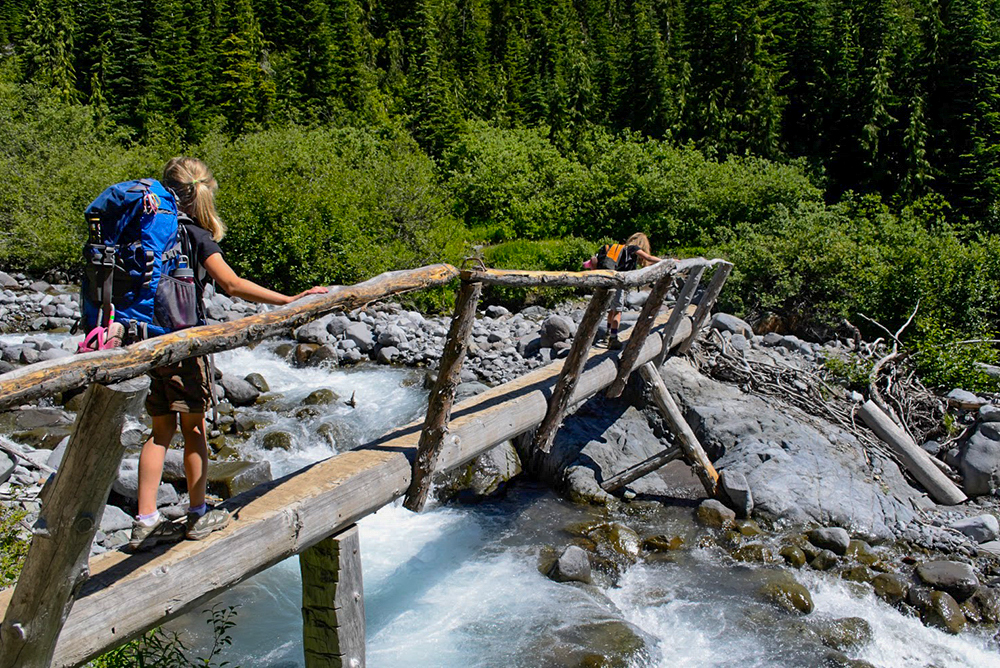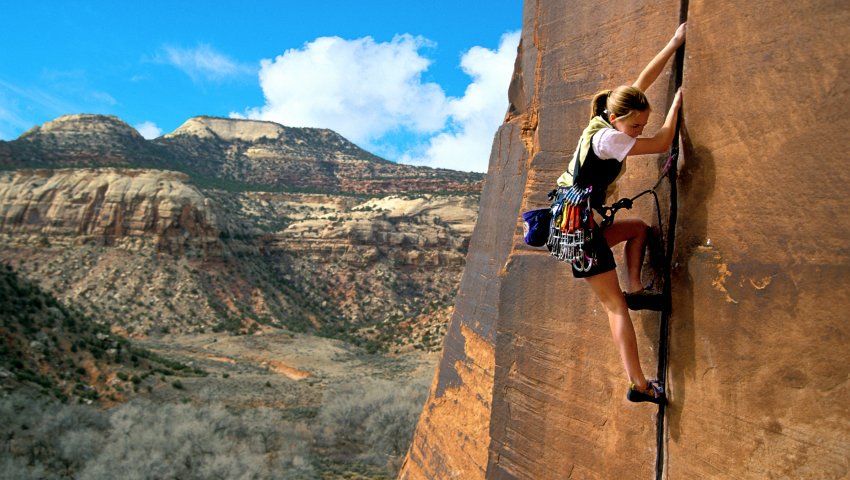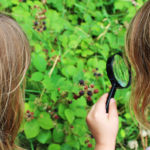
5 IDEAS FOR ADVENTURING WITH KIDS
1. Follow a way-marked trail
Waymarked walks are a great way to introduce children to the art of finding their way around a landscape. With a range of distances there’s always a route to suit everyone and no need to worry about getting lost. Children love spotting the different coloured arrows and having control over their adventure, with endless opportunities for exploration along the way.Simple route plans are available at many National Trust places, and these are a great introduction to map reading, with orienteering and geocaching being the next step up.Children also love a ‘point’ to a walk, rather than simply heading out for exercise or enjoyment.
Fun facts to keep in mind: children love spotting arrows and showing everyone else the way. Older kids might like to have a go at using the map to find their way too.
Best places to go:
- Parke (near Bovey Tracey, Devon TQ13 9JQ), has three excellent, adventurous way marked walks with arrows in different colours, perfect for younger children to spot. Many paths are also buggy-friendly and there’s an enclosed dog-free area near the cafe where small children can play safely.
- Croft Castle (Yarpole, near Leominster, Herefordshire, HR6 9PW), is a huge, beautiful castle with ‘proper’ turrets that will impress even the most knight-to-be. There’s even a mini version for children to play in. The estate is perfect for picnics and there’s a play area and way marked walks, some of which are specifically designed for children.
- Wallington (Cambo, near Morpeth, Northumberland, NE61 4AR), has secret gardens with ponds to explore. There’s an adventure playground, a play train and a ‘wild’ woodland, perfect for tree-climbing. Or head out into the 13,000 acres of lush estate, packed with a variety of walks to suit all abilities.
2. Go foraging
In our busy modern lives, it’s easy to forget the connection between food and nature.Growing a few easy things in pots or in the garden is a great way to introduce younger children to the life-cycle of the plant and our food’s need for water, sunshine and nourishment. It’s rewarding for children to plant, nurture and harvest something of their very own too.Foraging is something many of us naturally do when we pass a hedge laden with late summer blackberries, or walk beneath a tree heavy with plump, purple damsons. But this is just the start! If you know where – and when – to look, there’s a banquet of free, nutritious food that’s readily available and an adventure to find.Remember to only pick where the plant grows in abundance and don’t disturb or damage habitats. And if you’re not sure, don’t eat it!
Fun facts to keep in mind:
- Wild plants are protected by law in the UK but foliage, flowers and fruit aren’t, so these can be foraged, as long as you have permission to be on the property where they grow.
- Stinging nettles are one of the most widely available, easily identifiable and versatile wild plants. Their sting is deactivated with mild heat. Wear gloves to pick them, wash them well and use them like spring greens (in soups, pestos, stir-fries and curries).
- Of the 10,000 different food plants known, 150 have been cultivated and just 20 provide 90% of the world’s food requirements today.
Best places to go:
- Hembury and Holne Woods (Dartmoor, Devon) are lush, green ancient oak woodlands and a magical place for an adventure. They’re filled with wildlife and a great spot for foraging too. Mushrooms, whortleberries, nuts and blackberries are among the delights you’ll find. The River Dart flows through it all, perfect for paddling, swimming or skimming stones.
- Studland and Knoll Beach (near Swanage, Dorset, BH19 3AH) on Britain’s coastline has plenty of wild food for free from seafood to seaweed. Studland’s rangers run a kayak foraging trip where you’ll learn what you can eat and how to catch it.
- Roseberry Topping (Newton-under-Roseberry, North Yorkshire, TS9 6QR) has an abundance of wild garlic growing in the area, which is one of the easiest things to forage. This popular landmark, Yorkshire’s mini Matterhorn, is a thoroughly enjoyable – and achievable – climb to the summit where glorious views await.
3. Watch the sunrise
In our busy lives it’s tempting to feel that early mornings are best avoided, but when there’s no rush-hour train journey, no school run to do or desk to sit at, but just the gradual awakening of the natural world to appreciate, watching the sun rise on a new day can be magical.Kids are often surprisingly keen when it comes to an early morning expedition. For younger children simply sitting in the garden or by an open window watching and listening as the day arrives to the incredible sound of the dawn chorus is an adventure in its own right.
Fun facts to keep in mind:
- Sunrise is best when you have uninterrupted views to the east
- Moorland, mountain, downhill and levels are all great places to set up camp – in fact camping is one of the best ways to make sure you’re there, ready for the first rays of the day
- Coastal locations are particularly dramatic, as the sun appears to rise out of the sea
Best places to go:
- Avebury, Wiltshire
- Druridge Bay, Northumberland
- The White Cliffs of Dover, Kent
- Ventnor Downs, Isle of Wight
- Marsden Moor, West Yorkshire
- Lizard Point, Cornwall
- Dunwich Beach, Suffolk
- Brecon Beacons, Powys
- Carding Mill Valley, Shropshire
4) A barefoot adventure
Being barefoot is a lovely way to make a family walk really different. The soles of our feet are covered with nerve endings, meaning they’re highly sensitive to touch and going barefoot makes a way interactive and interesting. Try some of the following things to walk on:
- Sand: feel it sink under your weight; feel the difference between dry sand and wet sand; feel what happens as the waves wash over, and under, your feet
- Shingle: coarser than sand but finer than pebbles, shingle shifts constantly as you walk but fills in your footprints afterwards
- Pebbles: smooth, round and wonderful for curling your toes around, pebbles come in all sorts of shapes and sizes, colours and patterns
- Rocks: feeling your way across rocks in bare feet is fun and it’s a great challenge to jump between them
- Grass: the feeling of running barefoot on soft, springy grass is hard to beat
- Mud: deep mud can be utterly joyful to squelch through barefoot. Leave your laundry concerns behind and feel the mud squidgy between your toes.
Fun facts to keep in mind: the sole of the human foot has up to 200,000 nerve endings – that’s why they’re so ticklish!
Best places to go:
- Cragside (Rothbury, Morpeth, Northumberland, NE65 7PX) is filled with remnants of the genius of its former resident, Lord Armstrong. The gardens, including a huge rock garden, are exciting for all the family to explore and there’s a labyrinth and dedicated barefoot trail.
- Godolphin (Godolphin Cross, Helston, Cornwall, TR13 9RE) boasts some of the best views in Cornwall; south across to St Michael’s Mount and north to the startlingly-blue St Ives Bay. From mysterious woodland to riverside trails there’s so much here to encourage families to immerse themselves in nature, including the dedicated barefoot trail and outdoor mud kitchen.
- Dunwich beach (Dunwich, Saxmundham, Suffolk, IP17 3DJ) is brilliantly set up for families with children of any age. The beach is perfect for a barefoot exploration, with soft sand, rounded pebbles, dry or slimy seaweed and cold sea!
5. Explore a rock pool
Fun facts to keep in mind:
- Rock pools are tidal pools that are usually submerged at high tide and exposed as the sea-level falls
- There are many creatures and plants to be found in Britain’s rock pools: look for anemones, shore crabs, pipe fish, sea scorpion, spiny star fish, sucker fish, edible crabs and limpets
Best places to go:
- St Helens Duver (St Helens, Isle of Wight, PO33 1XY) is a great place for kids as there’s everything you need for a day out within easy reach. Plus there’s wildlife galore and fascinating history with archaeological findings that date back to the Stone Age.
- Wembury beach (Wembury, Devon, PL9 0HP) is one of the best places to go rock-pooling. Intriguing rock formations create fascinations bowls, trenches and basins where you’ll find crabs, anemones, starfish and limpets. There are also some great walks from the beach along the spectacular South West Coast Path.
- Strangford Lough (Strangford, County Down, Northern Ireland) with 150km2, it’s the largest sea lough in the British Isles. It’s a perfect place for budding naturalists, with over 2,000 species of marine wildlife to be found in or around the water.
5 IDEAS FOR ADVENTURING WITH BIGGER ONES

Fun facts to keep in mind:
- In Britain, a mountain is any high point over 610m (2,000ft) above sea-level with at least 30m (100ft) of ascent on all sides
- There are 179 mountains in England, 138 in Wales and 19 in Northern Ireland
- These mountains are sometimes known as HEWTTs, which stands fir Hill in England, Wales or Ireland over Two Thousand feet
Best places to go:
- Sugar Loaf and Skirrid Fawr (Brecon Beacons, Abergavenny, Monmouthshire, NP7 7LA) is a picture-perfect mountain (although at 486m/1,600ft not quite tall enough to be an official HEWITT) that rises out of the beautiful Usk Valley in the Black Mountain range. Skirrid is a great starter summit for first-time mountaineers or younger children, but it’s still a great day out with some more challenging options to suit all ages and abilities.
- Stickle Ghyll (Great Langdale, near Ambleside, Cumbria, LA22 9LU) up the mountainside to the gleaming shores of Stickle Tarn is a brilliant adventure. It’s generally straightforward walking, but there are a few fairly large step-ups that small children may require help with. When you reach the top, jump in the tarn for a paddle or a swim before heading back down or carry on past the face of Pavey Ark to reach High Raise at 762m (2,500ft).
- Mam Tor (near Castleton, Derbyshire, S33 8WA) standing at 517m (1,695ft) high, the summit of Mam Tor is one of the most dramatic viewpoints in the Peak District. From the summit you can see out over the Edale Valley to Kinder Scout and the Derwent Moors, or on a clear night it’s a wondering spot for stargazing. The walk is about half a mile (0.8km) from the car park, along clear, well-trodden paths and steps to the summit, where an ancient hill fort awaits exploration.
2. Ride a mountain bike trail
Best places to go:
- Leigh Woods, near Bristol is a haven of leafy tranquility. The Yer Tiz trail requires a mountain bike but is suitable for anyone who can ride confidently. There are lots of other family-friendly activities on, such as wilderness survival days and organised tree days.
- Ashridge Estate (Moneybury Hill, Ringshall, Near Berkhamsted, Hertfordshire, HP4 1LT) covers 2,000 acres of the Chiltern Hills. It’s criss-crossed by a vast network of trails, perfect for exploring on a mountain bike. Keep your eyes peeled for wildlife, including deer, rare butterflies and wildflowers.
- Lanhydrock (Bodmin, Cornwall, PL30 5AD) has six-graded trails, from the easy Lodge Trail to the technical and tricky red route, the Saw Pit. There’s even a skills area to practise in, Bike hire is available, including trailers – perfect for adventures with younger children.
3. Go wild swimming
Best places to go:
- Pig Island (Strangford Lough, Northern Ireland) is a sheltered sea swim with parking nearby and glorious views of the Mourne Mountains. At low tide, you can wade much of the way to the island but it gets much deeper when the tide is in. Keep an eye out for wind surfers.
- Carding Mill Valley (Shropshire, West Midlands). Deep in the Shropshire Hills there’s plenty to see and explore in this diverse, wildlife- rich area. Paddle in the stream that runs through the valley or swim in the reservoir – but make sure you read the information board first.
- Wasdale Head (Cumbria). Take the plunge on your own or join a guided swim in the remote and beautiful Wastwater, surrounded by Lake District fells. The best spot for swimming is known locally as the Blue Lagoon – it’s a 1.3-mile (2.1km) walk from the parking at Wasdale Head.
- Studland Bay (Dorset) is a great place for a first go at sea swimming, as it’s sheltered. There’s lots of sand for playing in and the Knoll Beach café for post-swim refreshments too.
- Compton Bay (Isle of Wight). The tide doesn’t go too far out here, leaving a good area of shallow water, perfect for sea swimming in relative safety. The beach is great for families too.
4. Go orienteering
Fun facts to keep in mind: Orienteering is a recognised sport that you can compete in to a high level. There’s a British, European and world championships held each year
Best places to go:
- Stonebarrow permanent orienteering course (Golden Cap Estate, Morcombelake, Bridport, Dorset). Walk or run around the glorious Golden Cap estate with views out across the Channel on one of three permanent orienteering courses. The Short Course is 0.6 miles (1km) with 7 control markers, the Medium Course is 1.2 miles (2km) with10 control markers and the Long Course is 2 miles (3.2km) with 13 control markers. Each red-and-white marker is affixed to a wooden structure and has a two-letter code for you to collect. The courses start and finish at the National Trust shop.
- Sherborne Park Estate (Lodge Park, Aldsworth, near Cheltenham, Gloucestershire GL54 3PP). Sherborne is a working estate with great, family-friendly walks, three of which are well-waymarked. Make sure you visit the eighteenth-century water meadows where, if you’re lucky, you might spot otters, water voles and dragon ies. The permanent orienteering trail here is a perfect introduction to the sport, with 13 markers set over a 1-mile (1.6km) course.
- Attingham Park (Atcham, Shrewsbury, Shropshire SY4 4TP). Explore the woods, discover the natural play eld and have a go at orienteering in the grounds of this eighteenth-century mansion with a turbulent past. It’s also a great place to explore the river in an open canoe or go tree climbing. Produce from the walled garden is available in the shop.
5. Go bouldering

There are many classic places to go bouldering, usually popular due to ease of access, an abundance of interesting rock formations and the type of rock.
Fun facts to keep in mind: You don’t have to go outside – if it’s a rainy day you could always head to one of the UK’s many indoor climbing or bouldering venues to hone your skills and techniques ready for the real thing.
Best places to go:
- Burble South (Derbyshire; www.peakbouldering.info) Just outside Sheffield in the Peak District, the gritstone boulders at Burbage have plenty of easier-grade problems with good, grassy landings.
- St Bees (Cumbria; www.lakesbloc.com) A wonderful day out at the seaside with dozens of sculpted sandstone boulders to play on.
- Great Langdale (Cumbria) Head for the Langdale Boulders or, at the National Trust campsite, there’s a purpose-built traversing wall.
- RAC boulders (Snowdonia, Gwynedd; www.northwalesbouldering.com) Lots of easier-grade bouldering with magni cent views, all within a short walk of the car park.
- Hound Tor (Dartmoor, Devon; www.javu.co.uk) Scramble right to the top of the tower of granite blocks or play on one of many lower down, high on the open moor.
 Jen Benson is a runner, writer and mum to two free-range children. Along with her co-author and husband, Sim, she has written and photographed a number of guidebooks including Wild Running, Amazing Family Adventures and The Adventurer’s Guide to Britain. In 2015/16 they lived under canvas for a year, exploring Britain with their two young children and a bell tent. jenandsimbenson.co.uk
Jen Benson is a runner, writer and mum to two free-range children. Along with her co-author and husband, Sim, she has written and photographed a number of guidebooks including Wild Running, Amazing Family Adventures and The Adventurer’s Guide to Britain. In 2015/16 they lived under canvas for a year, exploring Britain with their two young children and a bell tent. jenandsimbenson.co.uk





